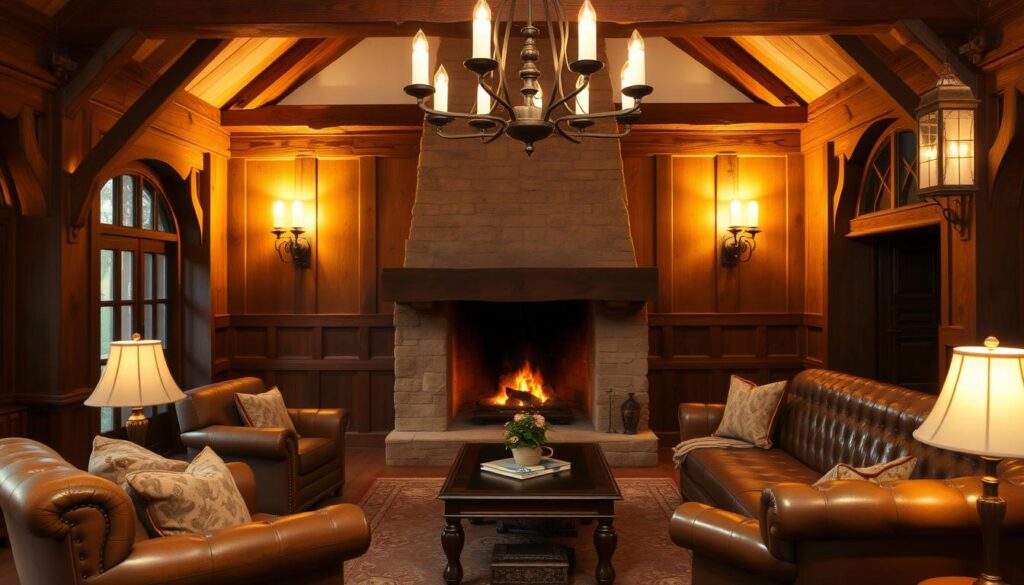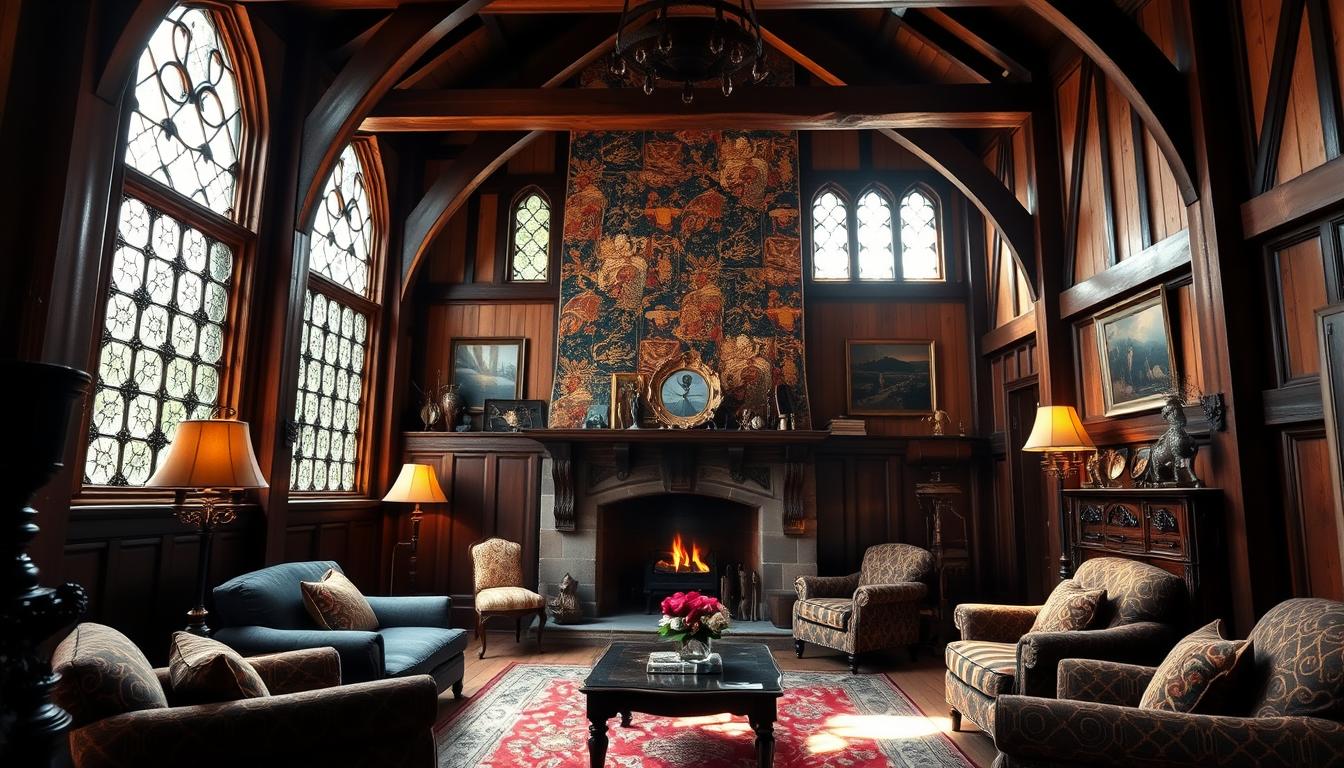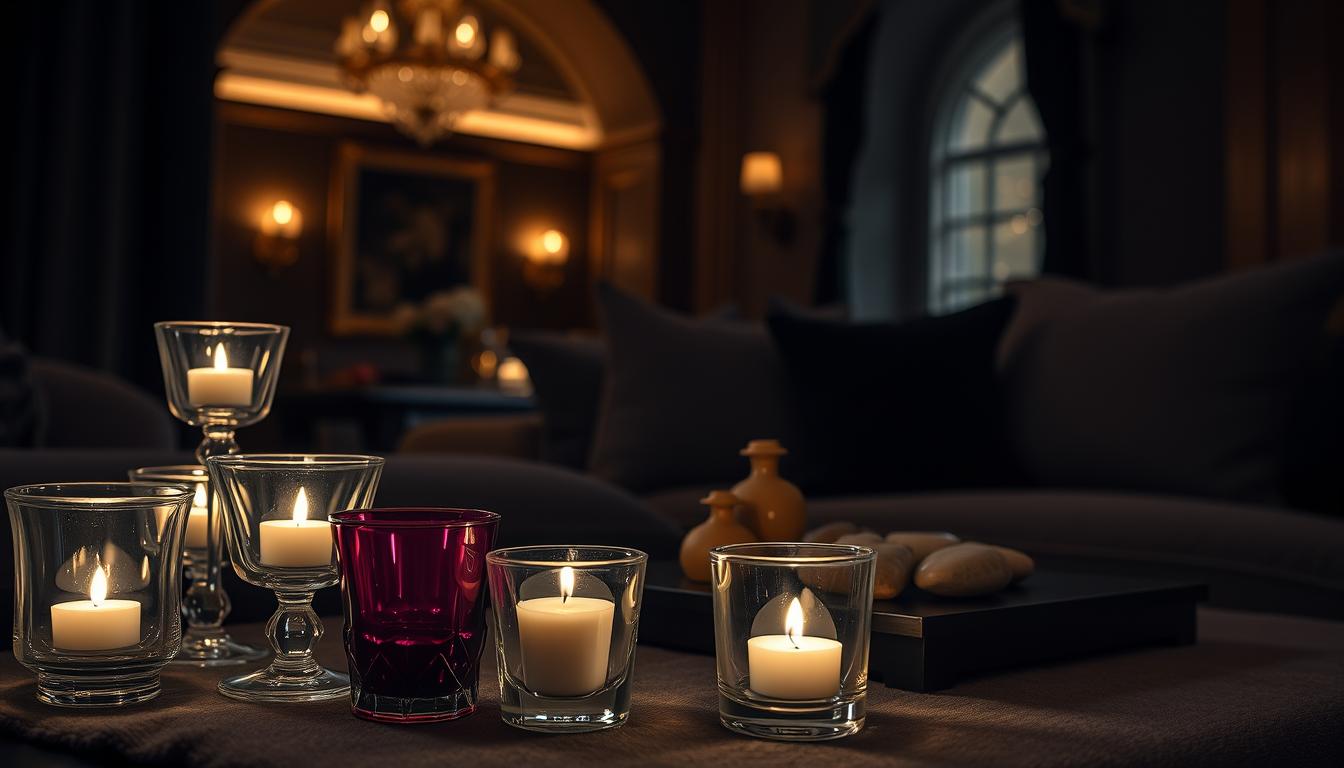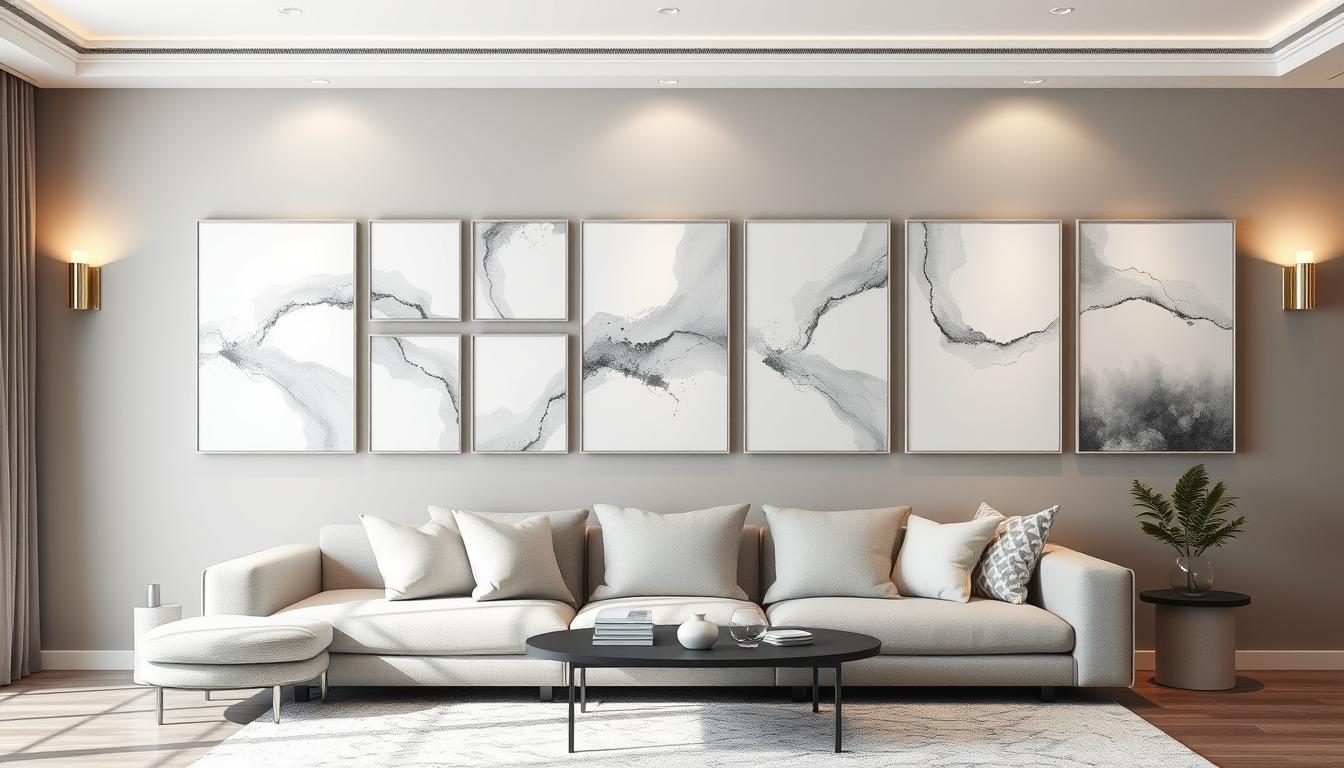Tudor homes have a unique style that makes renovation a challenge. They have a rich history and traditional features. It’s key to keep the original charm while adding modern touches. We’ll show how to update a Tudor home with interior design that respects its past and welcomes today’s design.
Renovating a Tudor home means carefully mixing old and new. You can keep traditional elements like patterned rugs and ironwork railing. Then, add modern pieces like contemporary seating and layered rugs. A recent project on Tudor house interior design shows how a muted color scheme works well. A grey base with clay accents brings together old and new beautifully.
Key Takeaways
- Balance traditional Tudor features with modern elements.
- Use a muted color palette to prevent overwhelming the space.
- Incorporate layered rugs for comfort and depth.
- Blend contemporary seating with traditional patterned rugs.
- Modernize with white marble accents and bold contemporary prints.
Understanding Tudor Architecture
Exploring Tudor architecture reveals why these homes are so beloved. They mix medieval and Renaissance styles, creating a unique look. This blend has attracted homeowners for centuries.
Key Features of Tudor Homes
Tudor homes stand out with their steeply pitched roofs and complex designs. They often have exposed half-timbering, where wood beams show on the outside or inside. Also, their ornate doorways and windows with multiple panes add to their charm.
“The Tudor style showcases the era’s craftsmanship,” says Dr. Jane Smith, an architectural historian. “These homes were built to last, with materials and techniques that have withstood time.”
Common Materials Used
Tudor homes are built with a mix of brick, stone, and timber. These materials boost the home’s strength and beauty. For example, brick and stone together create a striking contrast in texture and color.
- Brick: Provides durability and a classic look for the main structure.
- Stone: Adds elegance with its use in foundations, walls, and decorative elements.
- Timber: Exposed half-timbering brings warmth and character to the home.
The Historical Context
Tudor architecture came from the Tudor period in England, from the late 15th to early 17th century. It was shaped by cultural and economic changes, like the Renaissance and the rise of a wealthy class. Tudor homes thus blend medieval traditions with Renaissance innovations, making them a unique part of architectural history.
The history of Tudor homes is not just about their beginnings. It’s also about how they evolved over time. As styles and needs changed, Tudor homes adapted, keeping their classic charm while adding new elements.
Embracing Tudor Traditions
Keeping a Tudor home’s design true to its roots is more than just looks. It’s about keeping history alive. When updating or designing a Tudor home’s interior, finding a balance is key. This balance is between keeping traditional elements and adding modern comforts.
Tudor homes are full of history and charm. It’s important to respect their original features. This not only honors the home’s past but also makes it more beautiful and functional.
Maintaining Architectural Integrity
To keep a Tudor home’s architecture true, we must first identify and preserve its key features. This includes exposed wooden beams, ornate plasterwork, and traditional Tudor-style windows. Keeping these elements ensures the home’s original character is preserved.
| Feature | Preservation Tip | Modern Enhancement |
|---|---|---|
| Exposed Wooden Beams | Restore with traditional craftsmanship | Integrate modern lighting to highlight the beams |
| Ornate Plasterwork | Conserve and repair damaged areas | Use subtle color schemes to enhance the details |
| Tudor-Style Windows | Replace with historically accurate replicas if necessary | Add modern glazing for improved energy efficiency |
Celebrating Original Details
Celebrating a Tudor home’s original details is more than just preservation. It’s about making these features the heart of the interior design. For example, restoring original hardwood floors and highlighting antique fixtures can greatly enhance the home’s character.
By blending traditional elements with modern design, we can create a luxury Tudor home interior that’s both elegant and practical. This approach ensures the home stays true to its heritage while meeting today’s standards.
Embracing Tudor traditions in interior design is about honoring the home’s history while making it fit for today. With careful planning and attention to detail, we can achieve a modern Tudor home design that respects the past and welcomes the future.
Color Palettes for Tudor Interiors
The color palette of a Tudor home greatly affects its interior design. It should reflect the traditional warmth of this style. When picking colors, remember the historical context and architectural integrity of Tudor homes.
Warm, Earthy Tones
Tudor interiors are cozy and comfortable, thanks to warm, earthy tones. These colors come from the natural materials used in Tudor homes, like wood and stone.
- Rich Wood Tones: Oak, walnut, and other dark woods are typical of Tudor furniture and paneling.
- Earthy Reds and Browns: These colors remind us of the natural surroundings of Tudor homes.
- Muted Greens: Soft greens can add elegance and sophistication to Tudor interiors.
Accent Colors to Consider
While warm, earthy tones are the base of Tudor color palettes, accent colors add depth and interest. Here are some accent colors to consider for your Tudor interior:
- Deep Berry Shades: Rich berry colors can add a pop of color and create a cozy atmosphere.
- Golden Yellows: This warm, sunny color can highlight architectural details or add warmth to a room.
- Soft Blues: For a more subdued look, soft blues can create a calming and serene environment.
By choosing a color palette that balances warm, earthy tones with thoughtful accent colors, you can create a harmonious and inviting interior. This honors the classic Tudor style.
Furniture Selection and Arrangement
Finding the right furniture and arranging it well is key to a Tudor home’s charm. The right pieces can make the home look better and feel welcoming.

Choosing the Right Pieces
When picking furniture for a Tudor home, look for pieces that match the traditional style but also offer modern comforts. Ornate wooden furniture is a must-have. Choose items with detailed carvings and rich finishes to add depth and character.
Adding modern touches can also make your Tudor home more functional. Mix traditional Tudor styles with contemporary designs for a unique look. For example, a classic wooden dining table paired with modern chairs can be a great contrast.
| Furniture Style | Characteristics | Tips for Incorporation |
|---|---|---|
| Traditional Tudor | Ornate carvings, rich wood finishes | Use as statement pieces in living areas |
| Modern | Clean lines, minimal ornamentation | Blend with traditional pieces for contrast |
| Luxury | High-quality materials, sophisticated designs | Invest in a few luxury items to elevate the space |
Creating Cozy Spaces
To make a Tudor home cozy, it’s not just about the furniture. It’s also about how you arrange it. Start by focusing on room focal points like fireplaces or large windows. Arrange your furniture to highlight these features.
Think about the size of your furniture. Big, sturdy pieces can make a room feel cozy. Smaller pieces can make it feel more open. Layering textiles like throw blankets, rugs, and pillows adds warmth and texture.
For a luxury tudor home interiors look, use high-quality materials and sophisticated designs. This includes luxurious fabrics, statement lighting, and artwork that fits the Tudor style.
Layering Textures in Tudor Design
In Tudor design, layering textures is key to adding warmth and character. Mixing different materials and fabrics creates a rich, inviting atmosphere. This honors the traditional Tudor style while adding modern touches.
Fabrics That Enhance Warmth
Fabrics are crucial in Tudor interiors for adding warmth and depth. Velvet and linen are great for upholstery and drapery. They offer a tactile experience and visual warmth.
Velvet’s soft, luxurious pile creates a cozy atmosphere. Linen’s natural texture and breathability add sophistication. To enhance warmth, use throw blankets and pillows in rich, earthy tones. They add texture and tie the room’s color palette together.
Incorporating Natural Materials
Natural materials like wood, stone, and brick are essential for an authentic Tudor look. Exposed wooden beams add character to a room. Stone or brick walls bring a sense of solidity and history.
Here’s a table showing various natural materials for Tudor design:
| Material | Common Uses | Aesthetic Contribution |
|---|---|---|
| Wood | Flooring, Paneling, Beams | Warmth, Traditional feel |
| Stone | Walls, Fireplaces, Flooring | Solidity, Luxury |
| Brick | Walls, Exterior Facades | Historic feel, Texture |
By carefully layering these textures and materials, homeowners can make a Tudor home interior luxurious and inviting. It reflects the style’s rich heritage while embracing modern comforts.
Lighting Solutions for Tudor Homes
Lighting can change the feel of a Tudor home a lot. It’s key to pick the right lights and use natural light well. In Tudor style interior design, lights are not just for seeing; they also add beauty to your home.
When picking interior design for Tudor homes, choose lights that match the home’s rich history and feel. Look for fixtures that show off the Tudor look but also meet today’s lighting needs.
Choosing Statement Fixtures
Choosing the right lights can really make your tudor home interior decor stand out. Chandeliers, sconces, and pendant lights are great for adding elegance and style to your Tudor home.
- Chandeliers: Often with detailed designs, chandeliers can be a highlight in dining rooms or entryways.
- Sconces: These wall lights offer soft light and show off the home’s design.
- Pendant Lights: Over kitchen islands or dining tables, pendant lights mix modern with traditional charm.

Maximizing Natural Light
Getting more natural light is also key for interior design for Tudor homes. Big windows, skylights, and mirrors can bounce natural light around and brighten up the inside.
| Technique | Description | Benefit |
|---|---|---|
| Large Windows | Installing bigger windows or adding more to walls. | Brings in more natural light |
| Skylights | Adding skylights in places like hallways or stairwells. | Brings light from above |
| Mirrors | Putting mirrors by windows to spread light. | Makes light go further in the space |
By picking the right lights and using natural light well, you can make your Tudor home warm and welcoming. This will enhance its tudor style interior design and overall interior design tudor home look.
Modernizing Your Tudor Home
When we think about updating a Tudor home, finding a balance is key. We need to keep its history alive while adding modern comforts. This balance makes the home both cozy and true to its past.
Blending Contemporary and Traditional Styles
Mixing old and new in a Tudor home needs careful thought. We can do this by adding modern furniture that fits with the home’s classic look. For example, a sleek sofa can look great with traditional Tudor beams.
When looking at tudor home renovation ideas, we must respect the home’s original features. This might mean restoring woodwork, keeping historic windows, or using old materials in the update.
Ensuring Functionality and Comfort
Keeping a Tudor home functional and comfy is crucial. We can do this by updating its systems like electricity and plumbing, while keeping its charm. Adding smart home tech can also improve life without losing the home’s classic look.
For a timeless tudor home design, focus on quality materials and workmanship. Use traditional materials like oak and stone, or modern ones that look like them. The goal is to make a space that feels both new and connected to the past.
By mixing modern comforts with traditional styles, we can create a modern tudor home design. This design honors the home’s history while meeting today’s needs.
Accessorizing with Purpose
Tudor homes have a rich history and unique architecture. They are a blank canvas for interior design. To enhance their character, we must choose accessories thoughtfully.
Art and Decor that Compliment Tudor Style
Choosing art and decor for a Tudor home is key. We should pick items that match its traditional style. For example, classical paintings, rich textiles, and ornate metalwork are great choices.
A luxury tudor home interior might have antique furniture and vintage rugs. Elaborate lighting fixtures can also add to its charm.
It’s important to think about the Tudor design’s color palette and textures. Earthy tones, rich woods, and metallic accents create a warm atmosphere. Adding classic tudor home decor elements, like carved wooden panels, can enhance the space.
Sourcing Unique Finds
Finding unique items is essential for Tudor home decor. We can look in antique shops, estate sales, and online. These places offer one-of-a-kind pieces that add character.
When choosing items, consider their historical significance and craftsmanship. Think about how they fit with the home’s overall look.
| Item | Characteristics | Tips for Incorporation |
|---|---|---|
| Antique Furniture | Ornate carvings, rich woods | Use as statement pieces or refurbish to fit modern needs |
| Vintage Rugs | Rich textures, classic patterns | Layer under modern furniture or use in traditional settings |
| Metalwork | Ornate details, historical significance | Display as decorative pieces or incorporate into lighting fixtures |
By carefully choosing art and decor, we can make a home that’s both beautiful and meaningful. Our tudor home interior decor should honor the home’s heritage while showing our personal style.
Outdoor Spaces and Tudor Homes
Transforming our Tudor home’s interior is exciting. But, we must also think about the outdoor spaces. A well-designed area outside our home adds beauty and creates a peaceful spot for relaxation and fun.
Garden Landscaping Ideas
For landscaping, we can use nature as our guide. We can add lush greenery, stone paths, and classic furniture to reflect Tudor style. Choosing plants that do well in our area makes our outdoor space beautiful and easy to care for.
Creating Inviting Outdoor Living Areas
We can make our outdoor space welcoming. Designing patios and gardens that match our Tudor home’s look is key. Adding comfy seating, lights, and decorations turns our outdoor area into a perfect spot for dining and parties.



